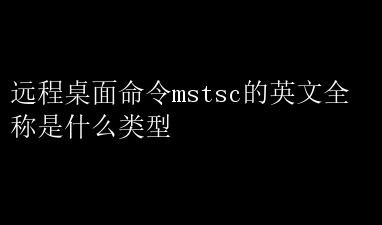
Exploring the Functionality and Usage of MSTSC: The Microsoft Remote Desktop Connection
In the realm of remote computing and administration, the Microsoft Remote Desktop Connection (MSTSC) tool stands as a powerful and versatile utility. Its full name, Microsoft Terminal Services Client, encapsulates the essence of its purpose: to enable users to establish secure connections to remote computers and desktops. This article aims to provide a comprehensive overview of MSTSC, its functionalities, and how it can be effectively utilized in various scenarios.
Introduction to MSTSC
MSTSC, as the acronym suggests, is a client-side application that allows users to connect to remote computers running Microsofts Terminal Services. These services, commonly known as Remote Desktop Services (RDS) or Remote Desktop Protocol (RDP), enable the sharing of desktops and applications between computers. MSTSC is a native component of the Windows operating system, available in most editions, making it a convenient and cost-effective solution for remote access.
Functionalities of MSTSC
MSTSC offers a range of functionalities that cater to different use cases. At its core, it provides a graphical user interface (GUI) for connecting to remote desktops, allowing users to interact with remote computers as if they were physically present. However, MSTSCs capabilities extend beyond simple desktop sharing.
One notable feature is the ability to connect to specific console sessions on a remote server. This is particularly useful for administrators who need to access the servers console for diagnostic or management purposes. Additionally, MSTSC supports the connection of multiple monitors, allowing users to extend their local desktop across multiple screens on the remote computer.
MSTSC also offers advanced configuration options that allow users to customize their remote desktop experience. These include adjusting the display resolution, color depth, and audio settings. Furthermore, MSTSC supports the use of saved connection files (known as .RDP files), which contain predefined connection settings and credentials, simplifying the connection process.
Using MSTSC
The process of using MSTSC is relatively straightforward. Users can initiate a remote desktop connection by launching the MSTSC application, either through the Start menu or by running the mstsc command in the command prompt. Once launched, users are prompted to enter the address or name of the remote computer they wish to connect to. Optionally, they can also specify additional parameters such as the port number and connection settings.
Once connected, users can interact with the remote desktop using their local keyboard, mouse, and monitor. All input and output are securely transmitted over the network using the RDP protocol, ensuring a responsive and secure remote computing experience.
Advanced Usage of MSTSC
Beyond its basic functionality, MSTSC also offers advanced usage options that can enhance the remote desktop experience. For example, users can utilize MSTSCs command-line interface to automate connection processes or integrate remote desktop connectivity into scripts and applications. Additionally, MSTSC supports the use of gateways and proxy servers, enabling users to connect to remote computers located behind firewalls or in private networks.
Conclusion
MSTSC is a robust and versatile remote desktop tool that enables users to connect to and interact with remote computers securely and efficiently. Its range of functionalities and ease of use make it a valuable asset for administrators, IT professionals, and end-users alike. By understanding and utilizing the advanced features of MSTSC, users can enhance their remote computing experience and streamline their work processes.
